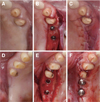1. Dawson PE. Functional Occlusion: from TMJ to smile design. St. Louis: Mosby Elsevier;2007. p. 430–466.
2. Akerly WB. Prosthodontic treatment of traumatic overlap of the anterior teeth. J Prosthet Dent. 1977; 38:26–34.

3. The council of professors of dental universities. Textbook of orthodontics. 3rd ed. Seoul: DaehanNarae Publishing;2006. p. 109p. 177–183.
4. The glossary of prosthodontic terms: Ninth edition. J Prosthet Dent. 2017; 117:e1–e105.
5. Okeson JP. Management of temporomandibular disorders and occlusion. 7th ed. St. Louis: Mosby Elsevier;2008. p. 56–61.
6. Beddis HP, Durey K, Alhilou A, Chan MF. The restorative management of the deep overbite. Br Dent J. 2014; 217:509–515.

7. Ramfjord SP, Ash MM Jr. Significance of occlusion in the etiology and treatment of early, moderate, and advanced periodontitis. J Periodontol. 1981; 52:511–517.

8. Gwon GR. The prosthetic approach for collapsed vertical dimension of occlusion. J Korea Acad Stomatognathic. 2004; 20:170–181.
9. Park JH, Jeong CM, Jeon YC, Lim JS. A study on the occlusal plane and the vertical dimension in Korean adults with natural dentition. J Korean Acad Prosthodont. 2005; 43:41–51.
10. Willis FM. Features of the face involved in full denture prosthesis. Dent Cosmos. 1935; 77:851–854.
11. Pleasure MA. Correct vertical dimension and freeway space. J Am Dent Assoc. 1951; 43:160–163.

12. Yang WS, Kim TW, Baek SH. Current orthodontic diagnosis. Seoul: DaehanNarae Publishing;2007. p. 447.
13. Rodriguez-Cardenas YA, Arriola-Guillen LE, Flores-Mir C. Björk-Jarabak cephalometric analysis on CBCT synthesized cephalograms with different dentofacial sagittal skeletal patterns. Dental Press J Orthod. 2014; 19:46–53.

14. Turner KA, Missirlian DM. Restoration of the extremely worn dentition. J Prosthet Dent. 1984; 52:467–474.

15. Orthlieb JD, Laurent M, Laplanche O. Cephalometric estimation of vertical dimension of occlusion. J Oral Rehabil. 2000; 27:802–807.

16. Abduo J, Lyons K. Clinical considerations for increasing occlusal vertical dimension: a review. Aust Dent J. 2012; 57:2–10.
















 PDF
PDF ePub
ePub Citation
Citation Print
Print









 XML Download
XML Download